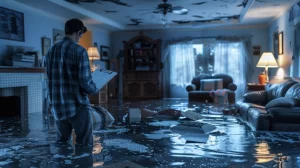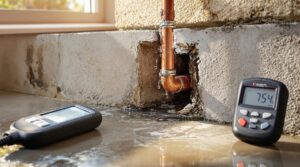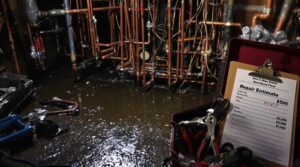Frozen pipes may thaw on their own as temperatures rise, but this poses significant risks, including catastrophic bursts and costly damage. Prolonged thawing increases ice expansion beyond pipe capacity, and natural thawing fails to relieve pressure buildup, increasing bursting risk. Allowing pipes to thaw on their own can lead to structural damage and increased repair costs. Understanding the risks and taking proactive steps can mitigate these issues and prevent future freezing incidents, a vital aspect of maintaining plumbing system integrity.
Key Takeaways
- Frozen pipes may thaw on their own as temperatures rise, but prolonged thawing increases the risk of ice expansion and bursting.
- Natural thawing fails to relieve pressure buildup, increasing the risk of pipe bursting and catastrophic damage.
- Outside temperatures below 20°F prolong freezing risks, making it unlikely for pipes to thaw on their own.
- Thawing frozen pipes without assistance can lead to long-term plumbing issues if not addressed promptly and properly.
- Prompt action and potentially seeking professional assistance are essential to minimize damage and ensure the plumbing system's integrity.
The Risks of Allowing Pipes to Thaw on Their Own
When frozen pipes are allowed to thaw on their own, the likelihood of costly damage and potentially catastrophic pipe bursts markedly increases.
The prolonged thawing process, which can take days or even weeks, enables ice expansion to exceed the pipe's capacity, leading to ruptures and substantial water damage.
As the temperature outside remains below 20 degrees Fahrenheit, the freezing and associated risks are prolonged.
The natural thawing process often fails to alleviate pressure buildup within the pipes, contributing to bursting when the ice begins to melt.
Allowing frozen pipes to thaw on their own is a high-risk strategy, as it increases the likelihood of pipe bursting and subsequent water damage, emphasizing the need for proactive measures to thaw a frozen pipe.
Steps to Thaw Frozen Pipes
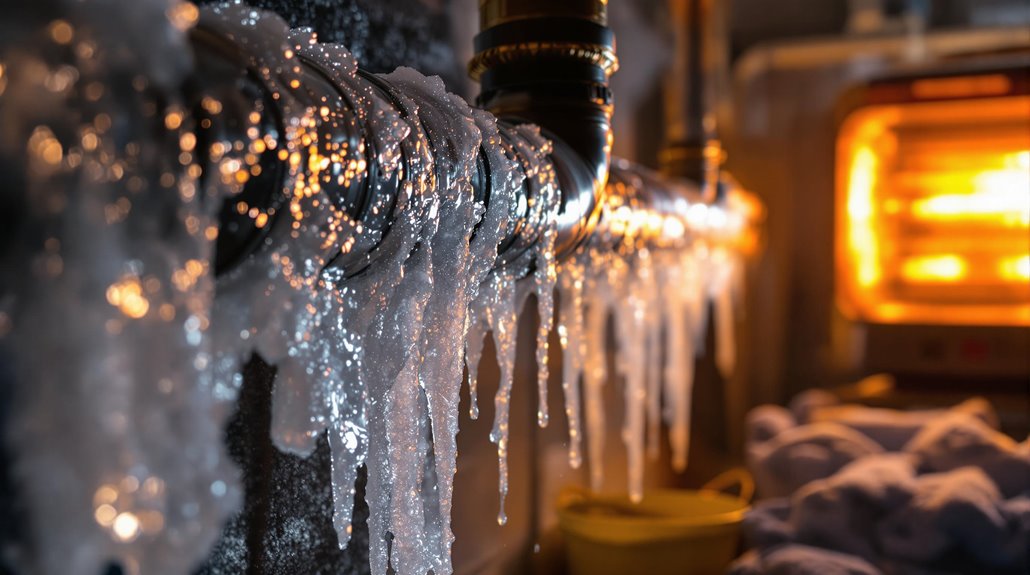
To initiate the thawing process, it is essential to locate the affected pipe and open both hot and cold faucets to relieve pressure and allow melted water to escape.
Thawing methods typically involve applying heat to the frozen pipe, with options including handheld hair dryers, heat tape, and portable heaters.
A controlled and gradual approach to thawing is vital to prevent damage to the frozen pipe and surrounding infrastructure.
Thawing Frozen Pipe Methods
Numerous methods can be employed to thaw frozen pipes effectively.
The first step is to locate the affected section and open both the hot and cold taps to relieve pressure and allow melted water to escape, thereby reestablishing water flow.
To initiate pipe thawing, apply heat gradually using a handheld hair dryer, space heater, or electric heating tape, taking care to avoid open flames.
Maintaining a warm ambient temperature in the area facilitates the thawing process. This can be achieved by opening cabinet doors and utilizing space heaters to circulate warm air.
Heat should be applied consistently until the pipe thaws, typically within thirty minutes.
If difficulties arise, it is recommended to seek assistance from a professional plumber to prevent damage.
Preventing Frozen Pipe Damage
Although thawing frozen pipes can be a relatively straightforward process, the aftermath of a prolonged freeze can be catastrophic if preventative measures are not taken.
Preventing frozen pipe damage is essential to avoid costly repairs and potential health hazards. When a pipe is frozen, it is vital to apply heat using hair dryers or space heaters to prevent ice expansion and potential ruptures.
To prevent pipes from freezing, homeowners should keep the thermostat set above 55°F and allow faucets to drip during cold weather. Insulating vulnerable pipes and covering outdoor spigots can also safeguard against future freezing incidents.
Proactive Approaches to Prevent Freezing
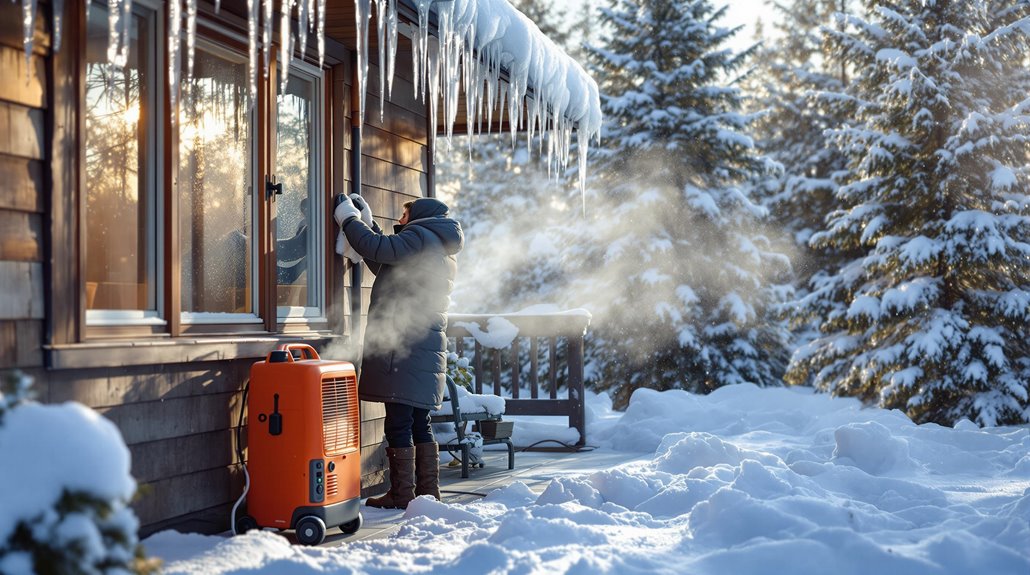
To prevent pipes from freezing, property owners can take several proactive measures.
Insulating exposed pipes in unheated areas, such as the garage, basement, or crawlspace, can provide protection against freezing temperatures.
Maintaining thermostat settings and letting faucets drip during extreme cold are additional strategies to reduce the risk of pipes freezing.
Insulate Exposed Pipes
A significant proportion of frozen pipe incidents can be attributed to a lack of insulation around exposed pipes in unheated areas.
Insulating exposed pipes is a proactive approach to prevent freezing by maintaining a higher temperature around the pipes, thereby reducing the risk of ice formation in temperatures below 32°F.
Using foam pipe insulation or fiberglass sleeves can effectively cover pipes in vulnerable areas such as basements, crawl spaces, and attics. This can reduce heat loss from hot water pipes, helping to keep water flowing even in extreme cold conditions.
Additionally, sealing cracks and openings in walls and around windows can maintain warmer temperatures in areas where pipes are located, further reducing the risk of freezing.
Maintain Thermostat Settings
Preventing pipe freezing is often a multi-faceted approach, where combining insulation with strategic thermostat management can provide extensive protection against cold temperatures.
Maintaining a consistent thermostat setting above 55°F during cold weather is vital in preventing pipes from freezing, especially when outside temperatures drop below 28°F. A stable indoor temperature allows warm air to circulate around plumbing, reducing the risk of ice formation in vulnerable areas.
Rapid temperature changes can increase the likelihood of freezing, so it's important to maintain consistent heating throughout the home. Raising the thermostat slightly higher during extreme cold spells can provide additional protection to exposed pipes.
Let Faucets Drip
During prolonged periods of extremely cold weather, numerous households can benefit from a simple yet effective technique to prevent pipes from freezing: letting faucets drip.
By allowing a steady drip from both hot and cold faucets, households can considerably lower the chances of freezing, especially in vulnerable areas of the plumbing system. Moving water is less likely to freeze than stagnant water, making this proactive measure particularly effective in preventing pipes from freezing.
Letting faucets drip can also relieve pressure in the pipes, reducing the risk of bursts if a section does freeze. To maintain a temperature above the freezing point within the pipes, it's recommended to let faucets drip slightly, especially when outdoor temperatures drop below 28°F, thereby mitigating all potential freezing points.
Identifying Frozen Pipes
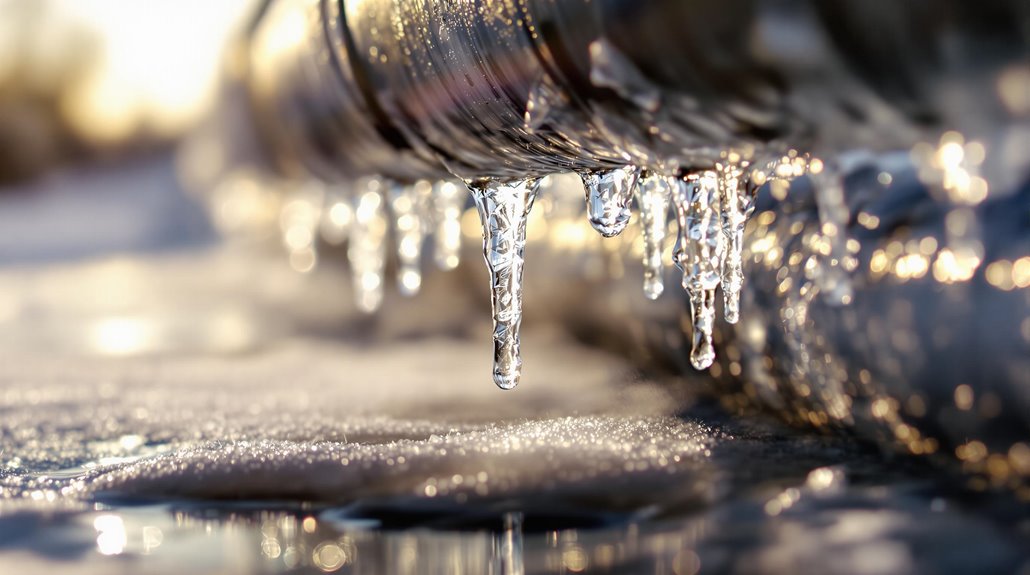
Because early detection is crucial in mitigating damage from frozen pipes, identifying the signs of freezing is essential. Homeowners can detect potential issues by recognizing reduced water flow from faucets, indicating blockages in the pipes.
Visible signs include frost or condensation on the pipes, as well as bulging pipes due to ice expansion. Unusual sounds, such as gurgling or banging, in the plumbing system also suggest freezing conditions.
Exterior walls and uninsulated areas are common locations where pipes are more susceptible to freezing. Identifying these signs allows homeowners to pinpoint potential problems in the water supply and take necessary actions to prevent further damage.
Regular inspections can help minimize the risk associated with frozen pipes.
What to Do When You Notice Signs of Frozen Pipes

Upon discovering signs of frozen pipes, prompt action is essential to minimize potential damage.
To mitigate further issues, the following steps should be taken:
- Shut off the water supply: Immediately shut off the water supply to prevent additional water from flowing into the pipe, which can exacerbate the issue.
- Open taps: Open both hot and cold taps to relieve pressure in the pipes and allow any melted water to escape.
- Gather necessary supplies: Collect mops and buckets to prepare for potential leaks and monitor for additional signs of thawing or bursting.
- Assess pipe accessibility: Evaluate the accessibility of the frozen pipe areas to determine if targeted thawing methods, such as using a space heater in a well-ventilated area, can be applied effectively to thaw the frozen pipes.
When to Seek Emergency Assistance
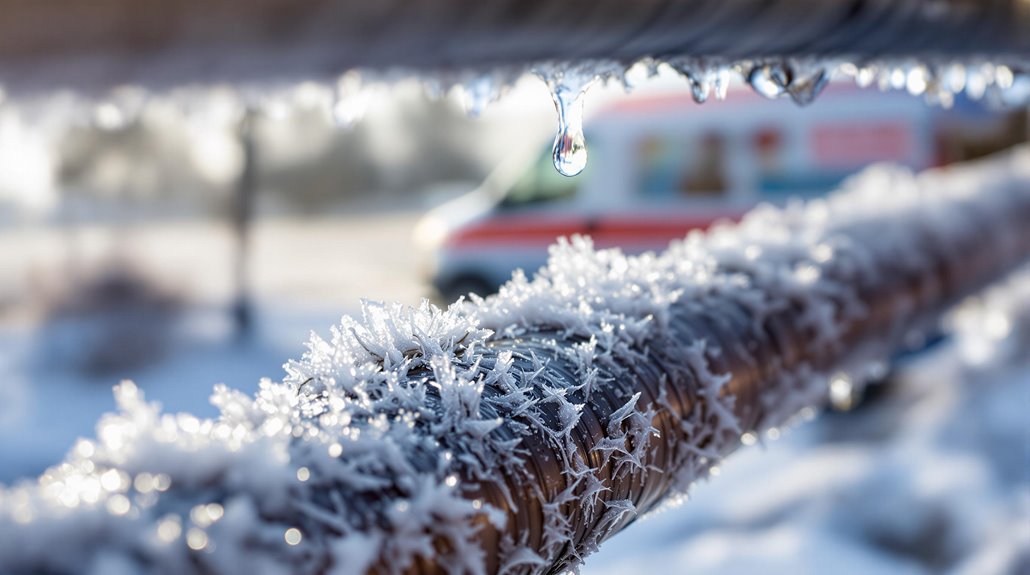
Frozen pipes can pose important risks to a building's plumbing system, and while prompt action can mitigate potential damage, there are situations where emergency assistance is necessary.
If signs of bulging pipes or gurgling sounds are observed, it is essential to seek emergency assistance, as these may signal imminent bursting risks.
Additionally, if attempts to thaw frozen pipes using safe methods are unsuccessful, contacting a professional plumber is advisable to prevent further damage.
In the event of a burst pipe, turning off the building's water valve and seeking emergency plumbing assistance immediately can greatly limit water damage.
Emergency assistance can help expedite the pipe thawing process, minimizing the risk of further damage and ensuring the plumbing system's integrity.
Frequently Asked Questions
How Long Does It Take Pipes to Unfreeze?
Pipes can thaw within several hours to days depending on temperature impacts and pipe material, with proactive pipe thawing techniques, such as direct heat application, expediting the process, typically in thirty minutes, versus relying on natural thawing methods.
Is It Better to Let Frozen Pipes Thaw on Their Own?
Like fragile glass on the brink of shattering, frozen pipes teeter on the edge of disaster. Thawing methods, combined with proper pipe insulation, shield against temperature fluctuations, emphasizing the importance of plumbing precautions to restore gentle water flow.
Can a Pipe Thaw Without Bursting?
A frozen pipe can thaw without bursting through proper pipe maintenance and winter preparation. Effective plumbing tips include monitoring and regulating water pressure, and implementing freeze prevention measures to prevent pipe damage during thawing.
Will Pouring Hot Water Down the Drain Unfreeze Pipes?
Pouring hot water down the drain is not a recommended thawing technique due to potential pressure buildup and damage to pipe insulation. Safer methods like localized heat application prioritize frozen pipe prevention over hot water methods.

